Who Knew I Was So catholic? (Not Catholic)
Hartford (Google Maps Location)
January 23, 2010
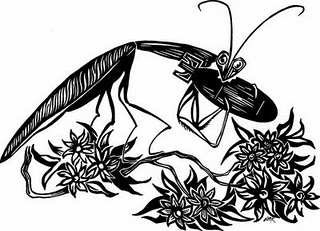 Ah, I see I’m up to my old clever tricks again with the title of this post. For some reason, I’ve always remembered my 7th grade vocabulary words and “catholic” was one of them. Small c catholic is an adjective which means, “broad or wide-ranging in tastes, interests, or the like; having sympathies with all; broad-minded; liberal.” Not exactly what one thinks about when one hears the word, eh?
Ah, I see I’m up to my old clever tricks again with the title of this post. For some reason, I’ve always remembered my 7th grade vocabulary words and “catholic” was one of them. Small c catholic is an adjective which means, “broad or wide-ranging in tastes, interests, or the like; having sympathies with all; broad-minded; liberal.” Not exactly what one thinks about when one hears the word, eh?
Another 7th grade word just popped into my brain – a word I’ve always enjoyed: Persiflage. Now there’s one near and dear to my cold, black heart. (Frivolous or bantering talk; a frivolous manner of treating any subject, whether serious or otherwise; light raillery.) Y’know, like how I’m about to talk about a catholic Catholic small art gallery at the Franciscan Center For Urban Ministry at St Patrick – St Anthony Church in downtown Hartford in a frivolous and flippant manner. That’s how I roll.
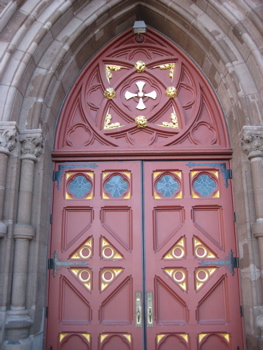 Longtime readers know that I’ve struggled mightily with what the CTMQ parameters surrounding art galleries are. Are they museums or aren’t they? And, if some of them are (in my world anyway), what makes them so special relative to ones I consider not to be? I’ve gone back and forth many times over the years on this question… And still don’t really have a coherent or definitive answer. I get fairly frequent emails from art gallery proprietors inviting me to exhibit openings and such, which only serves to cloud my thinking.
Longtime readers know that I’ve struggled mightily with what the CTMQ parameters surrounding art galleries are. Are they museums or aren’t they? And, if some of them are (in my world anyway), what makes them so special relative to ones I consider not to be? I’ve gone back and forth many times over the years on this question… And still don’t really have a coherent or definitive answer. I get fairly frequent emails from art gallery proprietors inviting me to exhibit openings and such, which only serves to cloud my thinking.
I used to say that I would include galleries that put on changing exhibitions throughout the year which are not commercial in nature. My intent was to rule out all those frame shops and chic-chic art galleries on brick walkways in towns like West Hartford, New Canaan and Westport. They’re only showing art to sell it, and that’s certainly not a museum in my book. Then there are the college are galleries (at almost every school in the state) that I decided qualify a while back. This decision alone added about 40 museums to my list.
And then we get to a level in between college art galleries and commercial shops. There are a ton of these; at churches, hospitals, community centers, private schools… I ignored these for a while, but kept seeing cool exhibitions that I wanted to check out merely because they looked interesting. But I think this subset of art galleries can never be said to definitely be on or off my giant list. Cases in point: The Clare Gallery is very small, but has hosted some very interesting and skilled artists – who don’t appear interested in selling their stuff in these settings. The next museum on my Visited List (#149) is another moderately sized gallery up at the Loomis Chafee school in Windsor. But there, the art was for sale… And yet, I say it qualifies. Because it just does, that’s why.
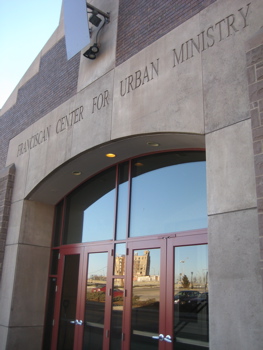 In contrast, my son goes to daycare at a church which also has a tiny art gallery with changing exhibits. Yeah, well, I checked it out and it’s nothing more than maybe 10 little works hanging on the wall around a wheelchair ramp from the old building to an addition that was built a few years ago. If I start including that stuff… Let’s just say I won’t and move on to the Clare Gallery.
In contrast, my son goes to daycare at a church which also has a tiny art gallery with changing exhibits. Yeah, well, I checked it out and it’s nothing more than maybe 10 little works hanging on the wall around a wheelchair ramp from the old building to an addition that was built a few years ago. If I start including that stuff… Let’s just say I won’t and move on to the Clare Gallery.
The Clare Gallery primarily features exhibitions that emphasize world religions or interfaith themes, as well as social justice themes, on either a global or local level. The Gallery is housed in the Franciscan Center for Urban Ministry which is part of St. Patrick – St. Anthony Church, a vibrant and active downtown faith community.
The church is beautiful – you can virtually tour it here – and is appropriately right on Church Street. It is also Connecticut’s oldest Roman Catholic Church. That’s right, St. Patrick-St. Anthony parish has played a central role in the rich history of the Catholic Church in Connecticut since its very beginning. Located in the heart of Connecticut’s capitol city, it traces its roots back to Holy Trinity parish, the first Catholic Church in Connecticut. Holy Trinity was founded in 1829 to welcome and serve the thousands of Irish immigrants who had begun to crowd into Hartford in the mid-19th century.
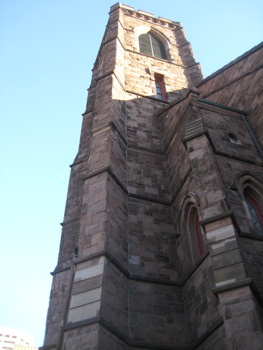 By 1849, the little parish that had begun with 126 members, had over 1,000 and needed a larger facility. The cornerstone for the new church was laid in 1850 at the corner of Ann and Church streets, the site of our present day church. In recognition of the overwhelming Irish heritage of its members, this new church was named St. Patrick. The church went through all the usual growing pains, but remains a vibrant centerpiece of Hartford’s Catholic tradition. Go ahead, read the whole history here.
By 1849, the little parish that had begun with 126 members, had over 1,000 and needed a larger facility. The cornerstone for the new church was laid in 1850 at the corner of Ann and Church streets, the site of our present day church. In recognition of the overwhelming Irish heritage of its members, this new church was named St. Patrick. The church went through all the usual growing pains, but remains a vibrant centerpiece of Hartford’s Catholic tradition. Go ahead, read the whole history here.
But the gallery is in an attached building, home to the Franciscan Center for Urban Ministry . Established in June of 1992 in, the Center continues its commitment to serve those in need. At the dedication of the Center, then Holy Name Province’s Provincial Minister, Fr. Anthony Carrozzo, OFM, gave the following remarks:
“Analysis by contemporary Franciscans,” Fr. Anthony explained, “has led us to confront the growing gap of inequality, the escalating violence in our homes and streets, the racial antagonisms that harden in the face of this inequality and violence, and the ideological blocks that make conversation impossible and confrontation inevitable. Our remedy is to return to the cities as many people flee them and to preach peace and reconciliation. In this urban agenda, we are spurred on by the words of St. Francis: ‘We have been called to heal wounds, to unite what has fallen apart and to bring home those who have lost their way.’ That is why we have come to Hartford: to heal, to unify and to welcome.”
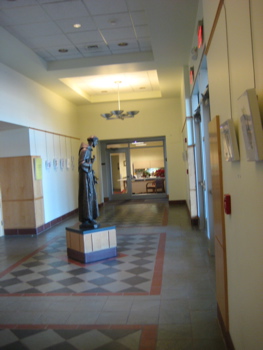 Impressive goals, Holy Name Province Provincial Minister Father Anthony Carrozzo, OFM. And you can’t really ask for a better location, just a quick walk over I-84 to some of the most violent urban areas in the country in Hartford’s north end. They do a lot of great stuff here – notably they provide a place for children from the North End of Hartford to have fun — keeping them off dangerous streets in marginalized neighborhoods through the Adventure Saturday Mentor Program. They also make and serve sandwiches to the homeless and working poor of Hartford 365 days a year. Most excellent.
Impressive goals, Holy Name Province Provincial Minister Father Anthony Carrozzo, OFM. And you can’t really ask for a better location, just a quick walk over I-84 to some of the most violent urban areas in the country in Hartford’s north end. They do a lot of great stuff here – notably they provide a place for children from the North End of Hartford to have fun — keeping them off dangerous streets in marginalized neighborhoods through the Adventure Saturday Mentor Program. They also make and serve sandwiches to the homeless and working poor of Hartford 365 days a year. Most excellent.
I stopped in on a bitterly cold Saturday afternoon to check out the gallery. The mission of the Clare Gallery is to promote the arts and to allow exhibits to educate and inform all who enter the facility. They state that they would not exclude any subject matter out of hand. However, it should be noted that as an urban Roman Catholic church, we are most interested in exhibitions that emphasize world religious or interfaith themes, and social justice themes, either on a global or local level. Hm. Sounds rather exclusionary to me – but I must note they have exhibited photographs of young Muslims in the past: “Beyond the Veil” explores how young Muslim women in our community maintain their identities and values in the face of American mass culture.” That was 5 years ago and I wonder how it fit in to the Center’s “Mass culture.” Get it?
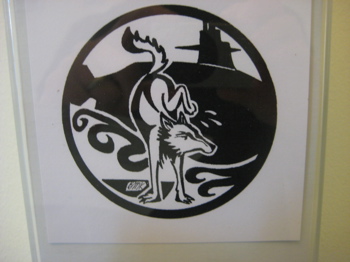 The exhibit I toured was A Prophet’s Ink: Drawings by Brian Kavanagh, Catholic Worker Artist. For over fourteen years Brian Kavanagh’s work has graced the pages of the Hartford Catholic Worker newsletter, reflecting the tradition of Christian pacifism and solidarity with the poor. Therefore, his artwork feels right at home in the communal meditative environment of the Clare Gallery at the Franciscan Center for Urban Ministry. The small drawings, artwork from 1997 to the present, are graphic in style referencing a woodcut texture. Themes of outrage, sorrow and hope are powerfully visible throughout the series.
The exhibit I toured was A Prophet’s Ink: Drawings by Brian Kavanagh, Catholic Worker Artist. For over fourteen years Brian Kavanagh’s work has graced the pages of the Hartford Catholic Worker newsletter, reflecting the tradition of Christian pacifism and solidarity with the poor. Therefore, his artwork feels right at home in the communal meditative environment of the Clare Gallery at the Franciscan Center for Urban Ministry. The small drawings, artwork from 1997 to the present, are graphic in style referencing a woodcut texture. Themes of outrage, sorrow and hope are powerfully visible throughout the series.
It was Kavanagh’s work that drew me to visit this place – otherwise, I may never have. I’m drawn to his style of drawing and the political nature of his work interests me. After all, in our all-too bloodthirsty country, sometimes the most religious Christians appear to love the idea of killing people. There sure is enough of it in the Old Testament. To be honest, I didn’t know if Kavanagh was a pacifist or a neocon warmonger before visiting. He – and the Center – surely side with the pacifists among us. It sounds funny to say, but I was sort of surprised about that, even if I was in a church.
The gallery itself is small, but attractive. It’s more or less in the lobby of the Center, with a life-size statue of Saint someone in the center of it all. Kavanagh’s darkly etched drawings provided a stark contrast to the quiet peacefulness of my environs. Since I can’t write about art, the following is from the fine blog called CT ArtScene and I really like the examination of A Prophet’s Ink: Drawings.
Kavanagh’s illustrations, mostly drawn for the Hartford Catholic Worker, are animated by a deep, Christian faith… These small illustrations—representing work from 1997 to the present—are stark and stylized, shot through with currents of sadness, empathy, hope and righteous anger. Aesthetically, they resemble woodcut or linoleum block prints. The line work is rich, not fussy, achieving a flow of interconnectedness. The subject matter is a mix of both Biblical iconography (Old Testament and New) and political commentary as seen through the prism of Christian allegory.
…
But for Kavanagh, much of the meaning and importance of his faith resides in its relevance to how we live today. Here, Kavanagh’s pen takes on the note of a prophet’s scorn. In torture, war and the expenditure of resources on implements of war, he sees an affront to the message of Christ. In “The Great Denial,” the Catholic Church’s own complicity with the war machine—the promulgation of the “just war theory”—is satirized with an image of a Pope wearing a mitre in the shape of a bomb. A Madonna-like figure shelters her shriveled child in “Iraq Sanctions.” Drawn in 1998, the image is a reminder that war may be conducted in many ways but with a consistent result: the suffering of the innocent. With this
illustration, Kavanagh also indicts those who abet the violence of war through their active and/or passive indifference. Among the crowd surrounding the woman and child, one figure covers his mouth, a woman hides her eyes and a third individual covers their ears. Speak no evil, see no evil, hear no evil: in this silence lies complicity.
The iconic image of the hooded prisoner in Abu Ghraib prison, with wires dangling from his outstretched arms, is the focus of “Christ of Abu Ghraib.” The box on which he stands reads “Inri,” the identification purportedly carved into the cross. To the left, two women and a child observe in sympathetic witness, one woman reaching out her hand to the figure. To the right is the chaotic horror unleashed by the war: a dog to terrorize the prisoners, soldiers in the street rounding up children, mindless displays of martial patriotism.
In all of Kavanagh’s drawings, there is the challenge. Whether implicit or explicit it is a call to witness, to struggle, to live in and for peace. A woodpecker in an untitled work hammers its beak into the outline of a bomb, carving out the silhouette of a dove with an olive branch. His “Logo for the Guantanamo Pilgrimage Against Torture” (2005)—a pilgrimage to the gates of the infamous detention center by pacifists and human rights activists including Catholic Worker ativists from Connecticut—depicts Jesus reaching down from his own agony on the cross to offer drink and succor to a kneeling, skeletal prisoner with shackles on his wrists and ankles.
Yeah – what he said. I think my favorite of Kavanagh’s drawings is his “Bomb Eating Mantis.” It’s just cool. But that blog adds a bit more intellectual flavor to it than I can: “This is heartfelt agit-prop for an active Christianity.”
The exhibit has moved on from the Clare Gallery, but check their site for the latest exhibitions and stop in next time you’ve had to park on the northside of the downtown area in Hartford. Yet another worthwhile little free diversion you didn’t know was there.

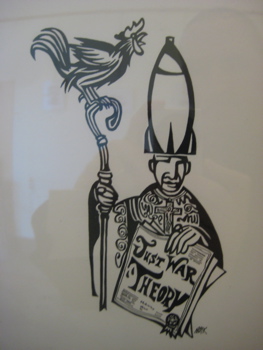
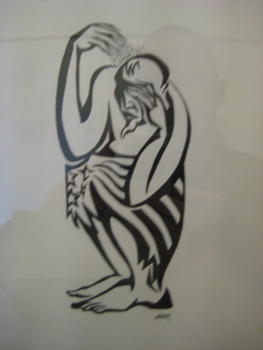
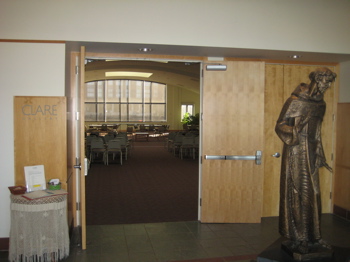
Leave a Reply